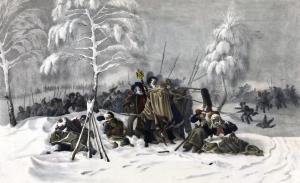As the rearguard of the Grande Armée, Ney‘s IIIrd Corps was the last to leave Smolensk. They had orders to blow up the walls of the city as they left. There
was plenty of powder in the city for this task, but the effect was minimal. Marshal Davout had sent back a messenger to warn Ney of the Russians across the road to Krasnoe, but Ney dismissed it saying something to the effect that all the Cossacks in the world wouldn’t bother him.
Davout’s corps had barely made it through to Krasnoe and now it was Ney’s turn to run the gauntlet. Ney left Smolensk on the morning of the 17th with 6,000 soldiers and thousands of camp-followers and stragglers. On the afternoon of the 18th, his lead troops came under fire through a heavy mist. The Russians had placed artillery across the road and along each side. To a request for surrender, Ney replied “A Marshal of France does not surrender.”
Accounts by Palmer, Nafziger and Ségur vary on the details, but in general, what followed is this: Ney tried to force his way through for five hours. Montesquiou Duc de Fezensac describes the fierce fighting as each cannon shot is “carrying off whole files. At each step death was becoming more inevitable. Yet our march wasn’t slowed down for a single instant.” The 18th Regiment of the line lost its Eagle when, as recorded by Captain Guillaume Bonnet, “The regiment impetuously continued its charge and, taking off to the right, threw back a line of infantry; but enveloped by numerous cavalry it was itself annihilated, except for two or three officers who’d been wounded early on… The Eagle was left there.”
General Jean-David Freytag describes the worsening conditions, “While we were ranged in order of battle in the plain, all the time standing up to a terrible and continuous fire, our carriages, our horses, part of the artillery and all the unarmed men, the stragglers and the sick who’d remained on the road, fell into the power of a ‘hurrah’ of Cossacks. All the food and the few resources still remaining to us were lost. Marshal Ney gave the orders that if possible the fight should be sustained until dusk, in order to retreat by the Dnieper.”
Fezensac described Ney’s determination, “Ney’s self-confidence equaled his courage. Without knowing what he meant to do nor what he could do, we knew he’d do something. The greater the danger, the prompter his determination; and once having made up his mind, he never doubted he’d succeed. His face expressed neither indecision nor disquietude.”
Leaving his camp fires burning, his army slipped away to the north toward the Dnieper river. Becoming disoriented in the dark, Ney had the ice of a stream broken so they could tell which direction the water flowed and follow it to the Dnieper. They reached the river around midnight, but found that the ice was not strong enough to support the crossing. Ney had the column sit and rest for three hours to allow the ice to harden. Any remaining wagons and artillery along with the sick and wounded were left on the bank. A fire was set on the far bank to guide any stragglers and the column moved on.
To be continued…
Sources:
1812: The Great Retreat, Paul Britten Austin, pp 195 – 197
Napoleon’s Russian Campaign, Philippe-Paul de Ségur
Napoleon in Russia, Alan Palmer
Napoleon’s Invasion of Russia, George F. Nafziger













